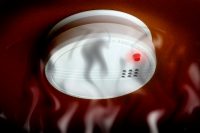Categories
- Additional Insured
- ChildrensProducts
- Claims Made
- Cyber Insurance
- Dietary Supplements and Nutraceuticals
- Ecigarettes
- Firearms Insurance
- Food Products
- Foreign Products Liability
- Foreseeable Misuse
- Frivolous Lawsuits
- General Liability
- Industrial
- Infographics
- Intellectual Property
- Looking ahead
- Marijuana Liability
- Medical Products
- Mutual Indemnification
- Nano Technology
- News
- Online Sellers Insurance Requirements
- Outsourcing
- Piercing The Corporate Veil
- Pollution Liability
- Product liability
- Product Recall
- Retail Chain Store
- Start-Up Business
- Statute of Repose
- Surplus Lines Insurance
- Technology
Product Liability and the Internet of Things

Is IoT a Pandora’s box of litigation?
While shopping for a smoke alarm I noticed that there are now wireless models on the market. When connected to a Wi-Fi network, the smoke alarm that senses smoke will set off all the other smoke alarms in the network. That’s pretty nifty technology for owners of large homes and commercial buildings where multiple alarms are installed.
But what if a hacker disables the network and sets the building on fire?
The Internet of Things is the development of technology wherein everyday objects are enabled with network connectivity, which allows them to send and receive data. The questions of product liability and IoT are only beginning to be asked.
Product Examples of Internet of Things
- Baby monitors that track breathing, skin temperature, activity levels and body positions
- Medicine caps that send messages reminding people to take their meds
- I’ve-fallen-and-can’t-get-up monitors for elderly and ill adults.
- Thermostats for homes
- Appliance sensors
- Maintenance and repair sensors for all types of industrial and medical equipment
When hackers compromise data, such as social security numbers and credit card accounts, the damage is indefinable and difficult to quantify. However, monetary damages are easier to assess in instances of physical damages such as a building burned to ashes or a vehicle damaged in an accident caused by disabled traffic lights.
Complications with IoT and Product Liability
In general, product liability means a manufacturer or seller is to be held liable for putting a defective product into a consumer’s hands. All the sellers in the product’s distribution chain are responsible for any defect that causes injury. So who is responsible if the device’s security is breached and damages result?
IoT device manufacturers, software developers and network providers must understand that consumers of their products could file product liability claims against them if the product malfunctions or experiences a security breach.
In addition to these new complications, the old ones still exist: Product liability laws are sorely lacking and largely legislated by the individual states.
IoT is likely to create new risks and a drastic increase in liability litigation. With most safety products, if the product does not work and and results in property damage or bodily injury, there is likely going to be a Product Liability lawsuit.
Source: Michael Kassner. “IoT and liability: Who pays when things go wrong?” techrepubic.com. 01 Aug., 2016.
-
 Click the Button Below to Get Your
Click the Button Below to Get Your
No-Obligation Quotes from Among the
Top 18 Leading Insurance Carriers Today -
Recent Industry News
- Amazon Sellers and Vendors Strategy Including Insurance Requirements
- Walmart Sellers Insurance
- Product Liability Limit Requirements of Online Sellers
- State-by-State Product Liability Analysis of Laws Impacting Businesses
- Children’s Product Liability: Strange Claims and Need for Insurance
- Product Liability vs. Environmental Insurance for the Chemical Industry
- Product Liability in the 3D Printing Industry: New Materials and Their Significance
- Product Liability Concerns in Agricultural Equipment Enhanced with Artificial Intelligence
- Navigate Product Liability in Battery and Solar Industry
- Cyber Risk Insurance Is Essential Business Insurance in Today’s Modern World
Monthly News Archives
